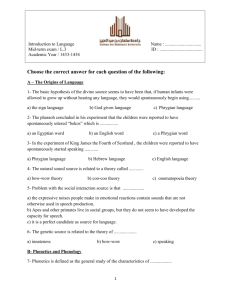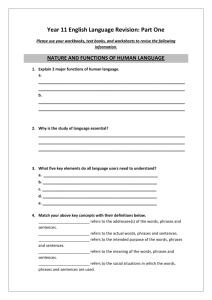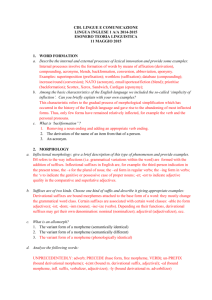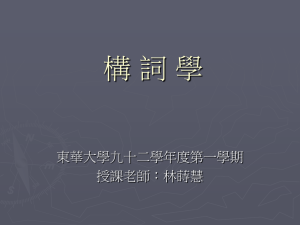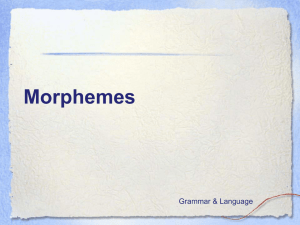Chapter 3: Word Structure
advertisement
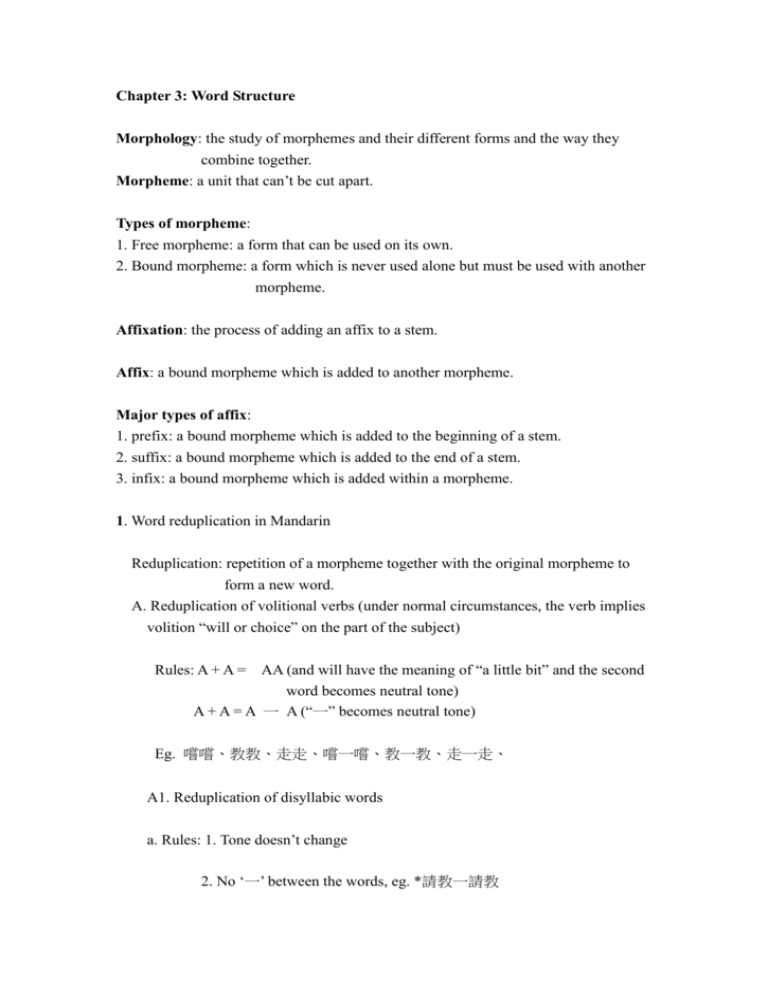
Chapter 3: Word Structure Morphology: the study of morphemes and their different forms and the way they combine together. Morpheme: a unit that can’t be cut apart. Types of morpheme: 1. Free morpheme: a form that can be used on its own. 2. Bound morpheme: a form which is never used alone but must be used with another morpheme. Affixation: the process of adding an affix to a stem. Affix: a bound morpheme which is added to another morpheme. Major types of affix: 1. prefix: a bound morpheme which is added to the beginning of a stem. 2. suffix: a bound morpheme which is added to the end of a stem. 3. infix: a bound morpheme which is added within a morpheme. 1. Word reduplication in Mandarin Reduplication: repetition of a morpheme together with the original morpheme to form a new word. A. Reduplication of volitional verbs (under normal circumstances, the verb implies volition “will or choice” on the part of the subject) Rules: A + A = AA (and will have the meaning of “a little bit” and the second word becomes neutral tone) A + A = A 一 A (“一” becomes neutral tone) Eg. 嚐嚐、教教、走走、嚐一嚐、教一教、走一走、 A1. Reduplication of disyllabic words a. Rules: 1. Tone doesn’t change 2. No ‘一’ between the words, eg. *請教一請教 b. If the volitional verb is a verb-object compound (and whose components are separable), then the verb can be reduplicated and the copied morpheme becomes neutral tone. c. If the volitional verb is a verb-object compound (and whose components are inseparable), then the whole compound is reduplicated. B. Reduplication of adjectives a. Modifiers of noun → more vivid description b. Modifiers of verb → manner adverb c. If an adjective is disyllabic, the two syllables are all required to be reduplicated. C. Reduplication of measure words Rule: When a monosyllabic measure word can be reduplicated, it has the meaning of “every”. D. Reduplication of kinship terms F. Miscellaneous reduplicated terms 2. Affixation (the process of adding an affix to a stem) in Mandarin A. Prefixes: add to the beginning of a morpheme 老、小、第、初、可、好、難 B. Infixes: add within a morpheme 得、不 (both usually occur in Resultative Verb Compounds) C. Suffixes: add to the end of a morpheme 兒、們、學、家、化、子、頭 3. Compounds: a combination of two or more words which functions as a single word. A. The meanings of compounds a. If A + B = C, the meaning of C has nothing to do with the meaning of A and B. eg. 風流、花生、小說 b. If A + B = C, the meaning of C has a symbolic or logical relation with the meaning of A and B. eg. 開關、熱心、公路 c. If A + B = C, the meaning of C has a direct relation with the meaning of A and B. eg. 乾淨、飛機、呼吸 B. Major types of compounds a. Nominal compounds: N + N b. Verbal compounds 1. Resultative Verb Compounds: the second element signals some result of the action or process conveyed by the first element. a. Directional: V (displacement) + V (direction) b. Phase: any of the stages of forms in any series or cycle of changes. c. Metaphorical: V + V (the second V has a symbolic sense) d. Obligatorily in potential form 2. Parallel Verb Compounds: V + V c. Subject-Predicate Compounds: S + P Three principles used to distinguish an S + P compound from an S + P sentence: 1. Compound in Mandarin is always a verb or noun 2. In general, an S + P compound can have idiomatic meanings 3. Most of the compounds contain at least one bound morpheme. d. Verb-Object Compounds: V + O Three principles used to identify a V + O compound. 1. Containing at least one bound morpheme 2. Idiomaticity 3. Inseparability or limited separability of the constituent. e. Antonymous Adjectives Forming Nominal Compounds Rule: Adj + Adj ( where the two adjs are antonyms) = noun C. Minor Types of Compounds 1. Adj + N 2. 3. 4. 5. Adv + Adv N + measure word or classifier N+V Adv + V
